YAMAHA SVHO 2009 Repair Manual
Manufacturer: YAMAHA, Model Year: 2009, Model line: SVHO, Model: YAMAHA SVHO 2009Pages: 108, PDF Size: 8.04 MB
Page 61 of 108
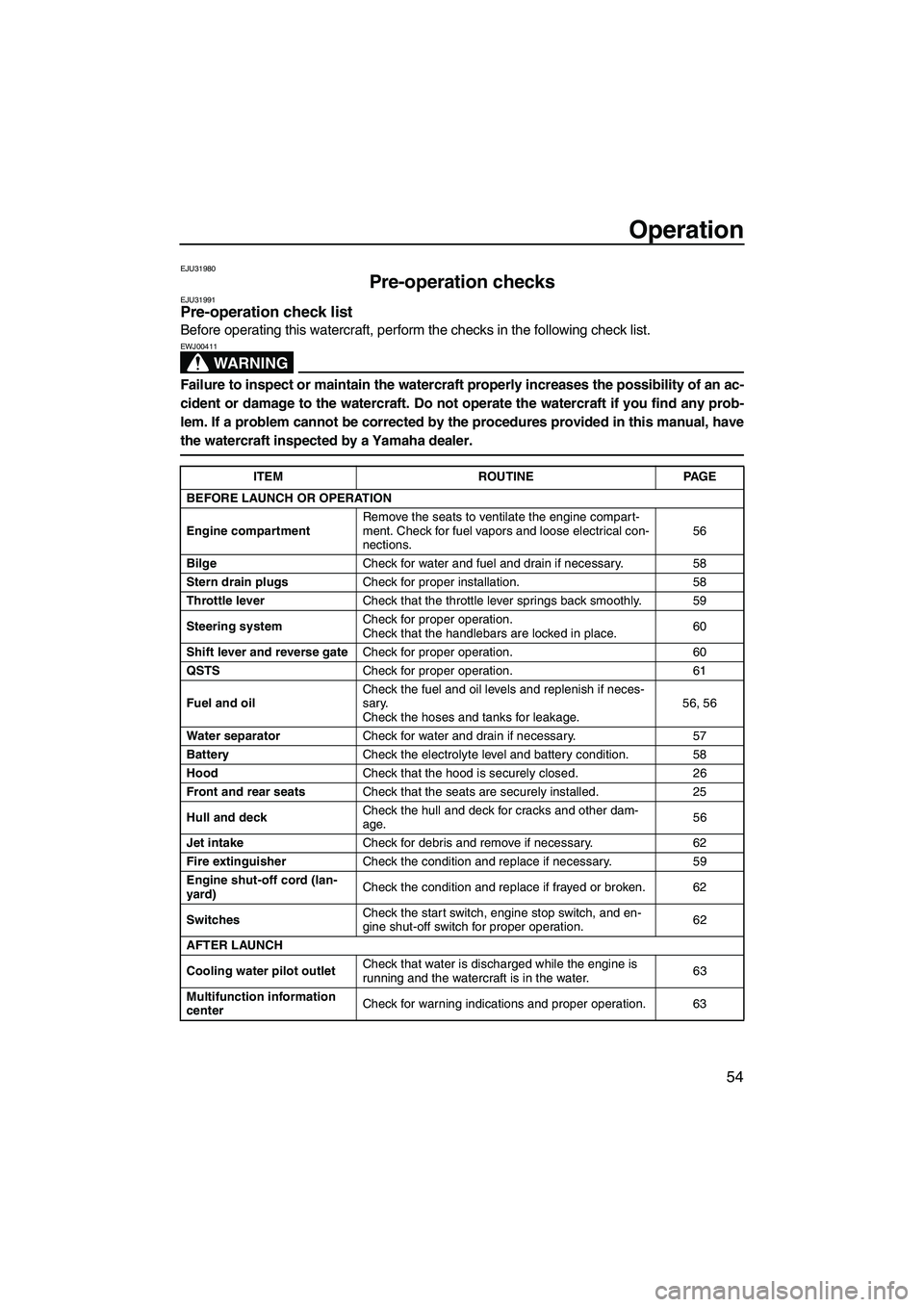
Operation
54
EJU31980
Pre-operation checks EJU31991Pre-operation check list
Before operating this watercraft, perform the checks in the following check list.
WARNING
EWJ00411
Failure to inspect or maintain the watercraft properly increases the possibility of an ac-
cident or damage to the watercraft. Do not operate the watercraft if you find any prob-
lem. If a problem cannot be corrected by the procedures provided in this manual, have
the watercraft inspected by a Yamaha dealer.
ITEM ROUTINE PAGE
BEFORE LAUNCH OR OPERATION
Engine compartmentRemove the seats to ventilate the engine compart-
ment. Check for fuel vapors and loose electrical con-
nections.56
BilgeCheck for water and fuel and drain if necessary. 58
Stern drain plugsCheck for proper installation. 58
Throttle leverCheck that the throttle lever springs back smoothly. 59
Steering systemCheck for proper operation.
Check that the handlebars are locked in place.60
Shift lever and reverse gateCheck for proper operation. 60
QSTSCheck for proper operation. 61
Fuel and oilCheck the fuel and oil levels and replenish if neces-
sary.
Check the hoses and tanks for leakage.56, 56
Water separatorCheck for water and drain if necessary. 57
BatteryCheck the electrolyte level and battery condition. 58
HoodCheck that the hood is securely closed. 26
Front and rear seatsCheck that the seats are securely installed. 25
Hull and deckCheck the hull and deck for cracks and other dam-
age.56
Jet intakeCheck for debris and remove if necessary. 62
Fire extinguisherCheck the condition and replace if necessary. 59
Engine shut-off cord (lan-
yard)Check the condition and replace if frayed or broken. 62
SwitchesCheck the start switch, engine stop switch, and en-
gine shut-off switch for proper operation.62
AFTER LAUNCH
Cooling water pilot outletCheck that water is discharged while the engine is
running and the watercraft is in the water.63
Multifunction information
centerCheck for warning indications and proper operation. 63
UF1W71E0.book Page 54 Tuesday, June 24, 2008 11:46 AM
Page 62 of 108
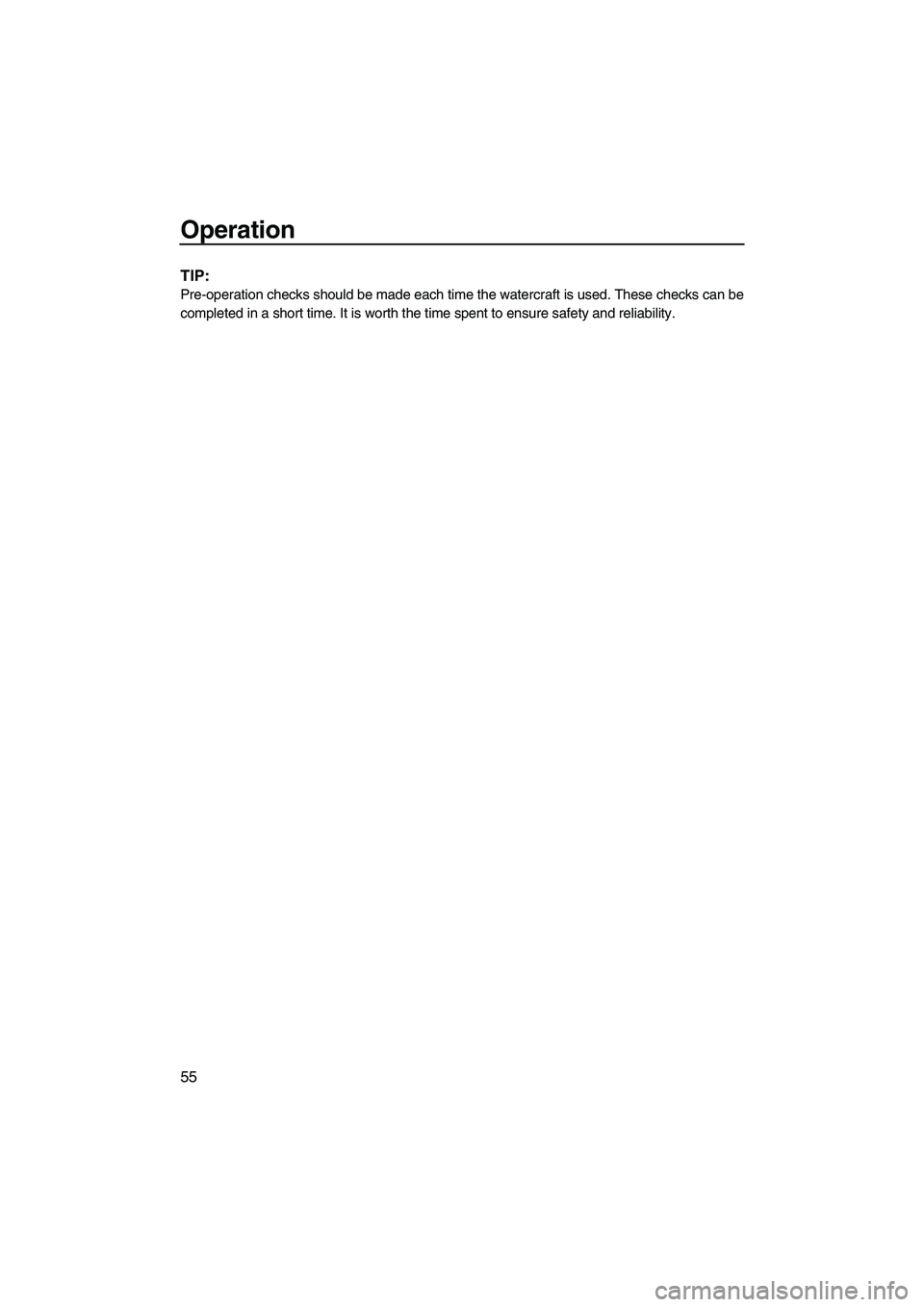
Operation
55
TIP:
Pre-operation checks should be made each time the watercraft is used. These checks can be
completed in a short time. It is worth the time spent to ensure safety and reliability.
UF1W71E0.book Page 55 Tuesday, June 24, 2008 11:46 AM
Page 63 of 108
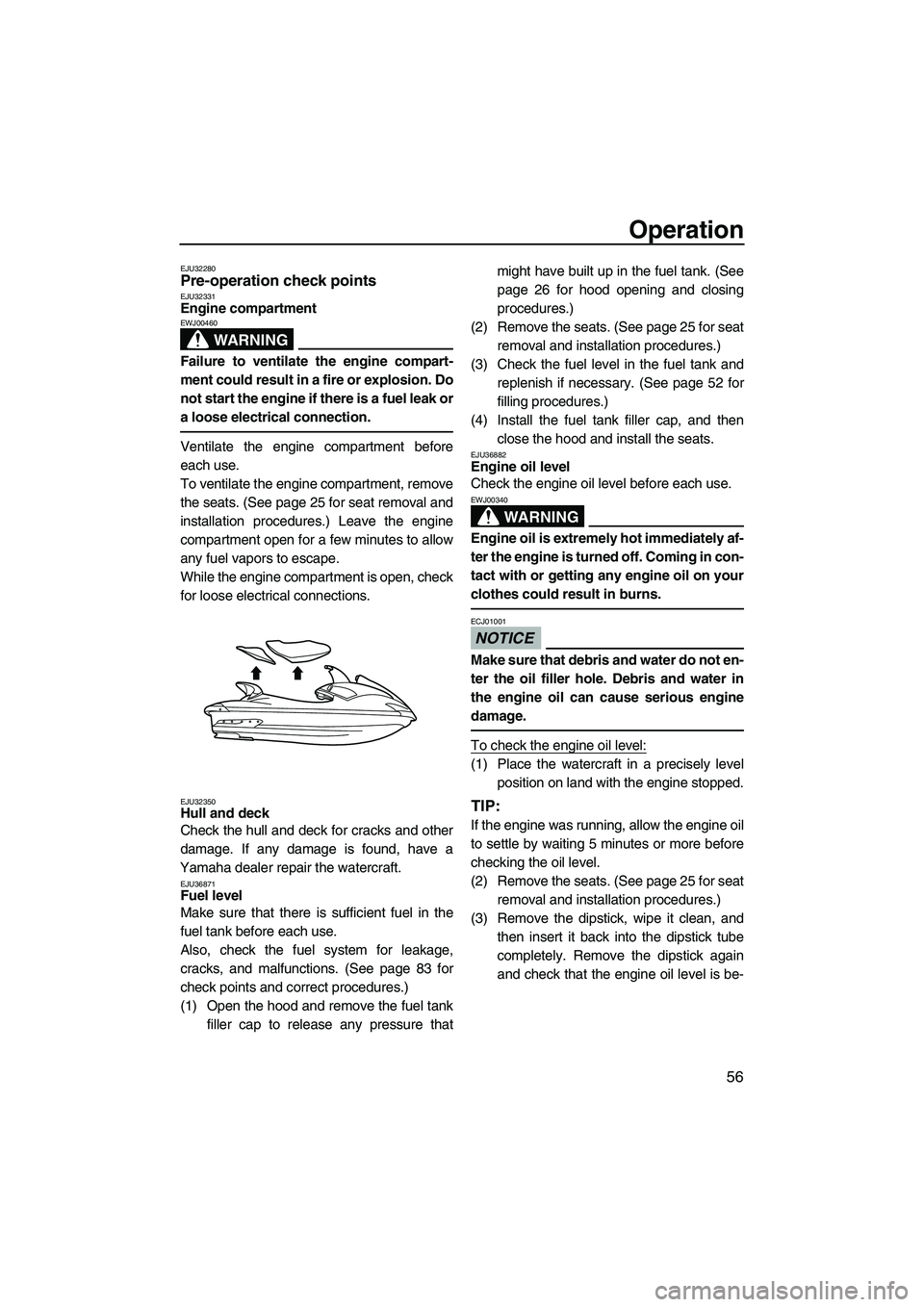
Operation
56
EJU32280Pre-operation check points EJU32331Engine compartment
WARNING
EWJ00460
Failure to ventilate the engine compart-
ment could result in a fire or explosion. Do
not start the engine if there is a fuel leak or
a loose electrical connection.
Ventilate the engine compartment before
each use.
To ventilate the engine compartment, remove
the seats. (See page 25 for seat removal and
installation procedures.) Leave the engine
compartment open for a few minutes to allow
any fuel vapors to escape.
While the engine compartment is open, check
for loose electrical connections.
EJU32350Hull and deck
Check the hull and deck for cracks and other
damage. If any damage is found, have a
Yamaha dealer repair the watercraft.
EJU36871Fuel level
Make sure that there is sufficient fuel in the
fuel tank before each use.
Also, check the fuel system for leakage,
cracks, and malfunctions. (See page 83 for
check points and correct procedures.)
(1) Open the hood and remove the fuel tank
filler cap to release any pressure thatmight have built up in the fuel tank. (See
page 26 for hood opening and closing
procedures.)
(2) Remove the seats. (See page 25 for seat
removal and installation procedures.)
(3) Check the fuel level in the fuel tank and
replenish if necessary. (See page 52 for
filling procedures.)
(4) Install the fuel tank filler cap, and then
close the hood and install the seats.
EJU36882Engine oil level
Check the engine oil level before each use.
WARNING
EWJ00340
Engine oil is extremely hot immediately af-
ter the engine is turned off. Coming in con-
tact with or getting any engine oil on your
clothes could result in burns.
NOTICE
ECJ01001
Make sure that debris and water do not en-
ter the oil filler hole. Debris and water in
the engine oil can cause serious engine
damage.
To check the engine oil level:
(1) Place the watercraft in a precisely level
position on land with the engine stopped.
TIP:
If the engine was running, allow the engine oil
to settle by waiting 5 minutes or more before
checking the oil level.
(2) Remove the seats. (See page 25 for seat
removal and installation procedures.)
(3) Remove the dipstick, wipe it clean, and
then insert it back into the dipstick tube
completely. Remove the dipstick again
and check that the engine oil level is be-
UF1W71E0.book Page 56 Tuesday, June 24, 2008 11:46 AM
Page 64 of 108
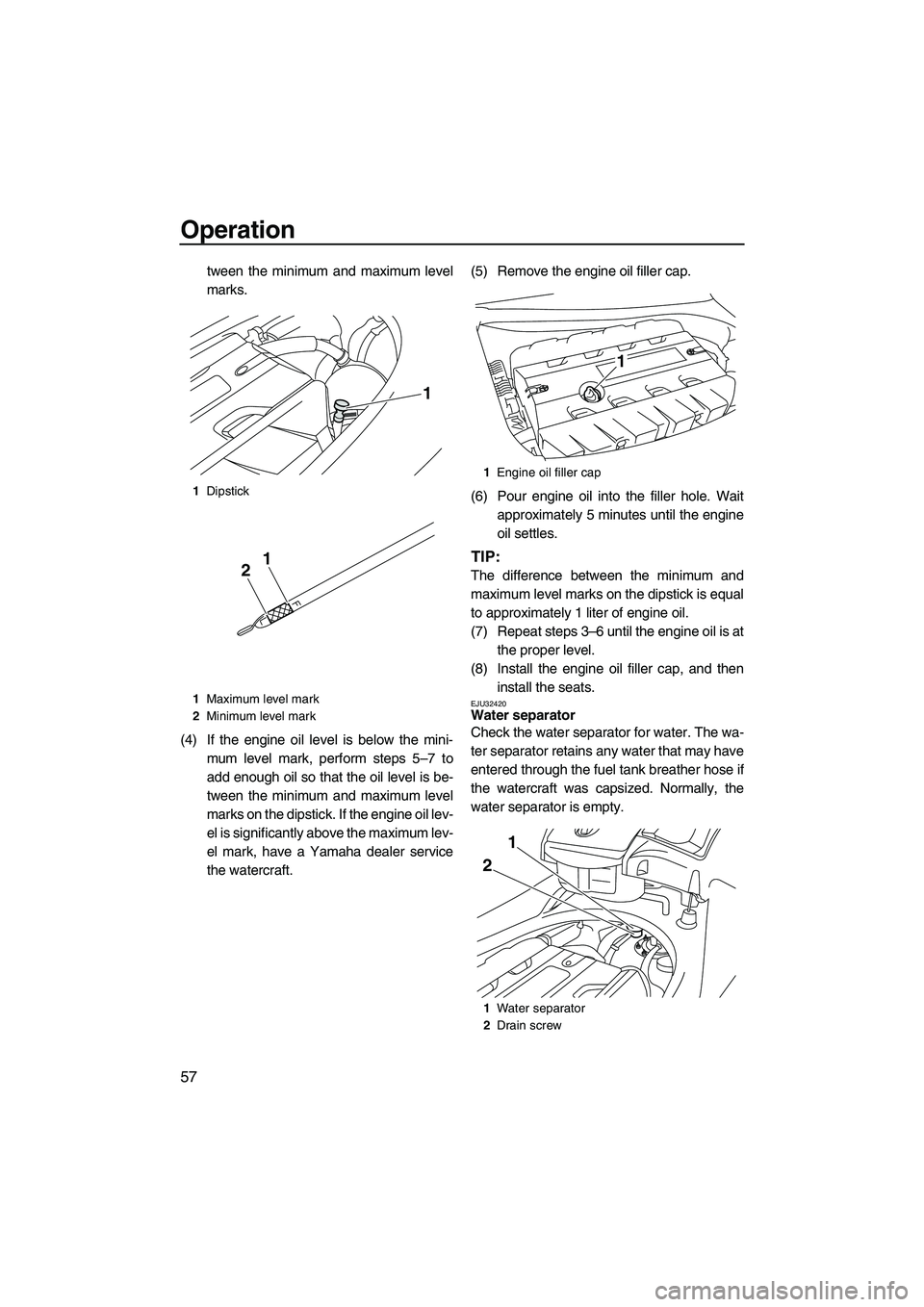
Operation
57
tween the minimum and maximum level
marks.
(4) If the engine oil level is below the mini-
mum level mark, perform steps 5–7 to
add enough oil so that the oil level is be-
tween the minimum and maximum level
marks on the dipstick. If the engine oil lev-
el is significantly above the maximum lev-
el mark, have a Yamaha dealer service
the watercraft.(5) Remove the engine oil filler cap.
(6) Pour engine oil into the filler hole. Wait
approximately 5 minutes until the engine
oil settles.
TIP:
The difference between the minimum and
maximum level marks on the dipstick is equal
to approximately 1 liter of engine oil.
(7) Repeat steps 3–6 until the engine oil is at
the proper level.
(8) Install the engine oil filler cap, and then
install the seats.
EJU32420Water separator
Check the water separator for water. The wa-
ter separator retains any water that may have
entered through the fuel tank breather hose if
the watercraft was capsized. Normally, the
water separator is empty.
1Dipstick
1Maximum level mark
2Minimum level mark
1
12
1Engine oil filler cap
1Water separator
2Drain screw
1
1
2
UF1W71E0.book Page 57 Tuesday, June 24, 2008 11:46 AM
Page 65 of 108
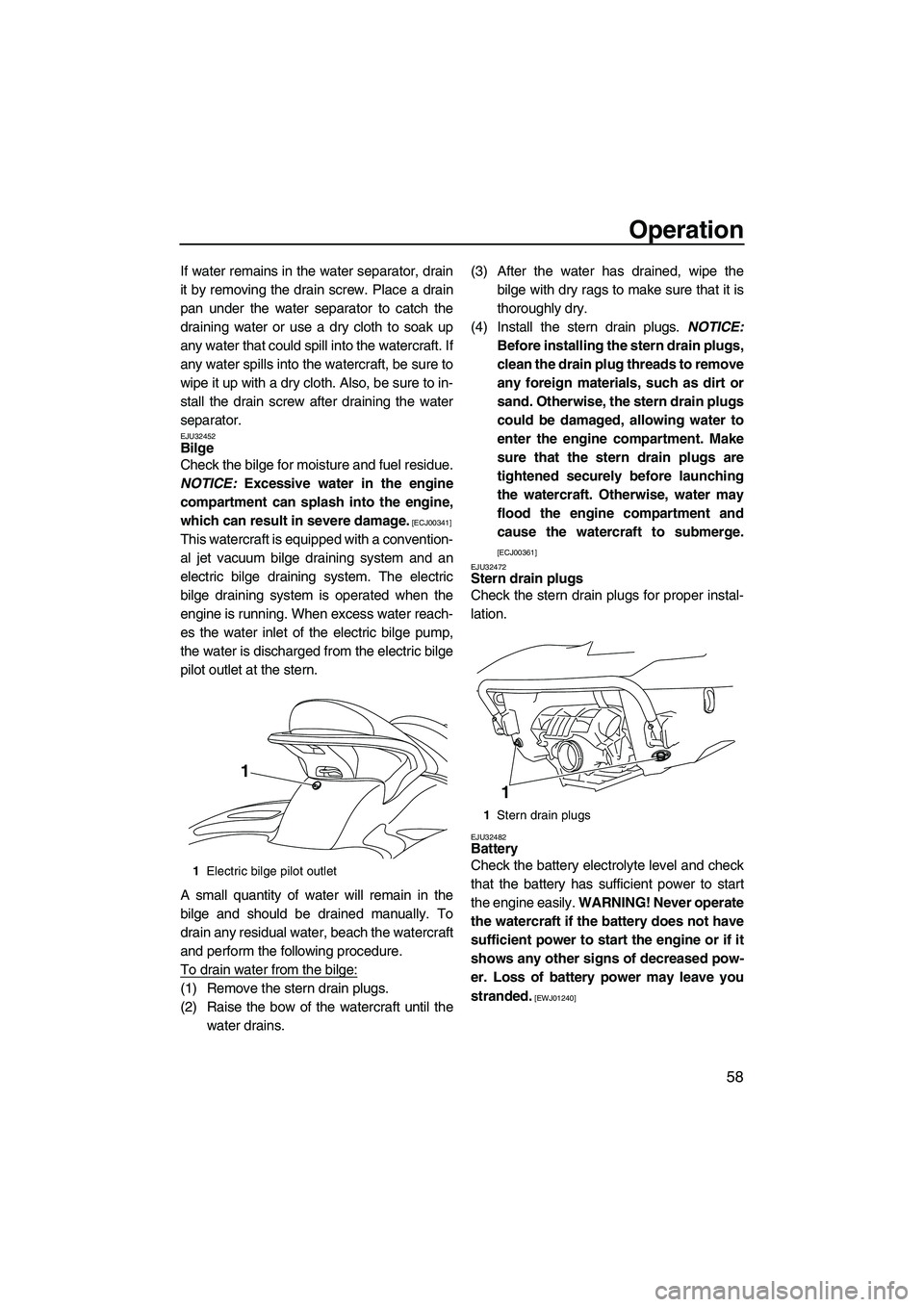
Operation
58
If water remains in the water separator, drain
it by removing the drain screw. Place a drain
pan under the water separator to catch the
draining water or use a dry cloth to soak up
any water that could spill into the watercraft. If
any water spills into the watercraft, be sure to
wipe it up with a dry cloth. Also, be sure to in-
stall the drain screw after draining the water
separator.
EJU32452Bilge
Check the bilge for moisture and fuel residue.
NOTICE: Excessive water in the engine
compartment can splash into the engine,
which can result in severe damage.
[ECJ00341]
This watercraft is equipped with a convention-
al jet vacuum bilge draining system and an
electric bilge draining system. The electric
bilge draining system is operated when the
engine is running. When excess water reach-
es the water inlet of the electric bilge pump,
the water is discharged from the electric bilge
pilot outlet at the stern.
A small quantity of water will remain in the
bilge and should be drained manually. To
drain any residual water, beach the watercraft
and perform the following procedure.
To drain water from the bilge:
(1) Remove the stern drain plugs.
(2) Raise the bow of the watercraft until the
water drains.(3) After the water has drained, wipe the
bilge with dry rags to make sure that it is
thoroughly dry.
(4) Install the stern drain plugs. NOTICE:
Before installing the stern drain plugs,
clean the drain plug threads to remove
any foreign materials, such as dirt or
sand. Otherwise, the stern drain plugs
could be damaged, allowing water to
enter the engine compartment. Make
sure that the stern drain plugs are
tightened securely before launching
the watercraft. Otherwise, water may
flood the engine compartment and
cause the watercraft to submerge.
[ECJ00361]
EJU32472
Stern drain plugs
Check the stern drain plugs for proper instal-
lation.
EJU32482Battery
Check the battery electrolyte level and check
that the battery has sufficient power to start
the engine easily. WARNING! Never operate
the watercraft if the battery does not have
sufficient power to start the engine or if it
shows any other signs of decreased pow-
er. Loss of battery power may leave you
stranded.
[EWJ01240]
1Electric bilge pilot outlet
1
1Stern drain plugs
1
UF1W71E0.book Page 58 Tuesday, June 24, 2008 11:46 AM
Page 66 of 108
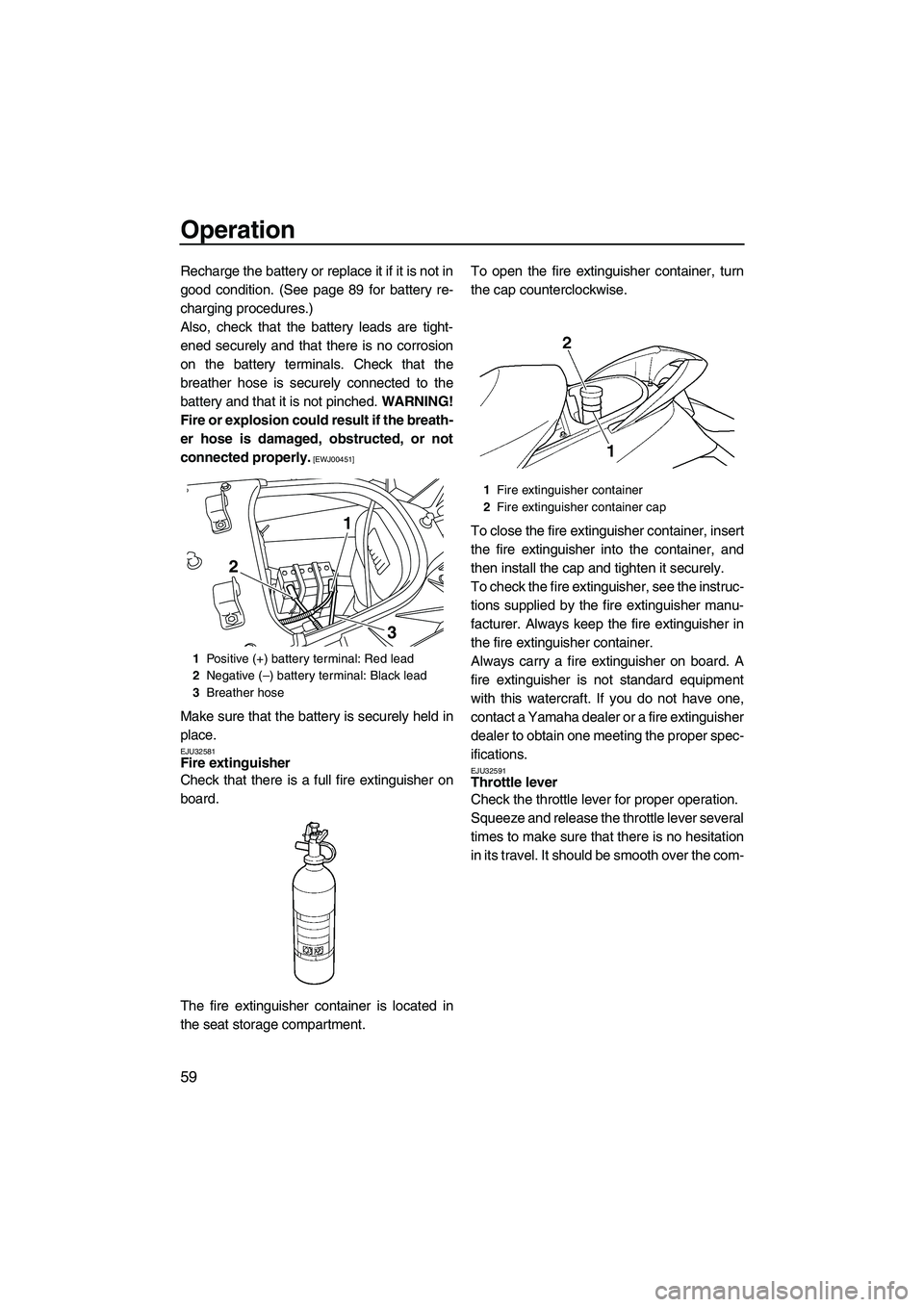
Operation
59
Recharge the battery or replace it if it is not in
good condition. (See page 89 for battery re-
charging procedures.)
Also, check that the battery leads are tight-
ened securely and that there is no corrosion
on the battery terminals. Check that the
breather hose is securely connected to the
battery and that it is not pinched. WARNING!
Fire or explosion could result if the breath-
er hose is damaged, obstructed, or not
connected properly.
[EWJ00451]
Make sure that the battery is securely held in
place.
EJU32581Fire extinguisher
Check that there is a full fire extinguisher on
board.
The fire extinguisher container is located in
the seat storage compartment.To open the fire extinguisher container, turn
the cap counterclockwise.
To close the fire extinguisher container, insert
the fire extinguisher into the container, and
then install the cap and tighten it securely.
To check the fire extinguisher, see the instruc-
tions supplied by the fire extinguisher manu-
facturer. Always keep the fire extinguisher in
the fire extinguisher container.
Always carry a fire extinguisher on board. A
fire extinguisher is not standard equipment
with this watercraft. If you do not have one,
contact a Yamaha dealer or a fire extinguisher
dealer to obtain one meeting the proper spec-
ifications.EJU32591Throttle lever
Check the throttle lever for proper operation.
Squeeze and release the throttle lever several
times to make sure that there is no hesitation
in its travel. It should be smooth over the com-
1Positive (+) battery terminal: Red lead
2Negative (–) battery terminal: Black lead
3Breather hose
3
1
2
1Fire extinguisher container
2Fire extinguisher container cap
UF1W71E0.book Page 59 Tuesday, June 24, 2008 11:46 AM
Page 67 of 108
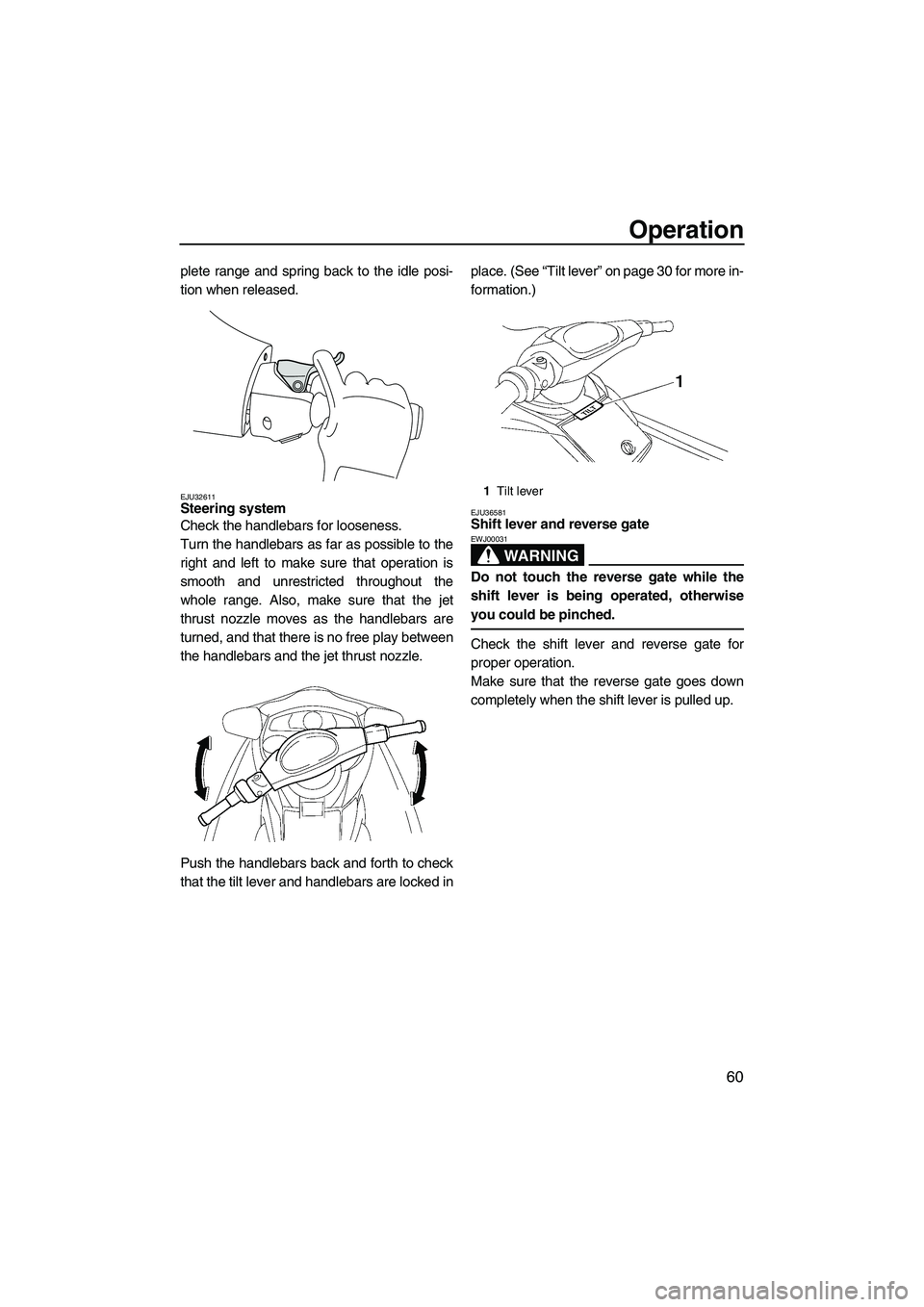
Operation
60
plete range and spring back to the idle posi-
tion when released.
EJU32611Steering system
Check the handlebars for looseness.
Turn the handlebars as far as possible to the
right and left to make sure that operation is
smooth and unrestricted throughout the
whole range. Also, make sure that the jet
thrust nozzle moves as the handlebars are
turned, and that there is no free play between
the handlebars and the jet thrust nozzle.
Push the handlebars back and forth to check
that the tilt lever and handlebars are locked inplace. (See “Tilt lever” on page 30 for more in-
formation.)EJU36581Shift lever and reverse gate
WARNING
EWJ00031
Do not touch the reverse gate while the
shift lever is being operated, otherwise
you could be pinched.
Check the shift lever and reverse gate for
proper operation.
Make sure that the reverse gate goes down
completely when the shift lever is pulled up.
1Tilt lever
UF1W71E0.book Page 60 Tuesday, June 24, 2008 11:46 AM
Page 68 of 108
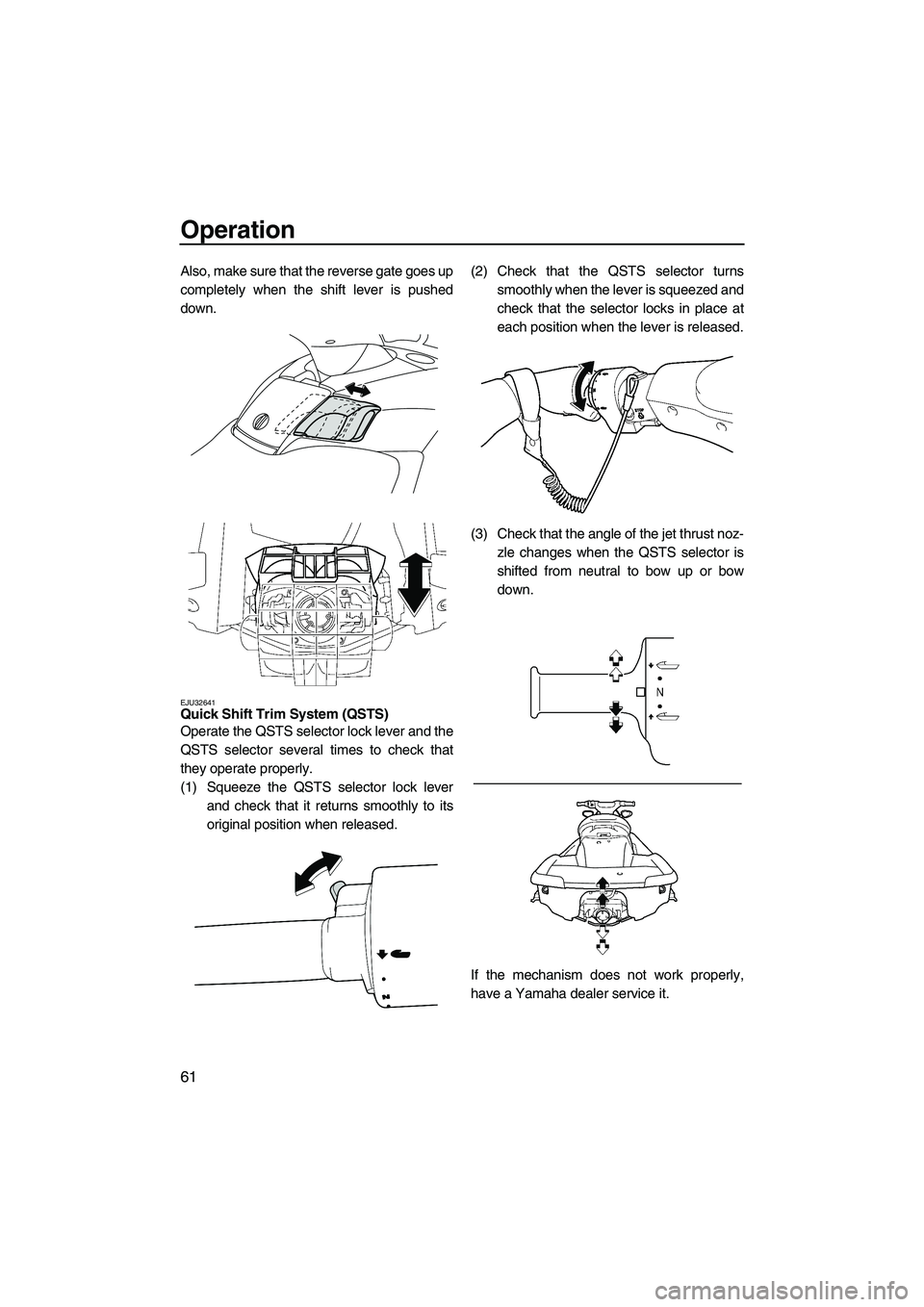
Operation
61
Also, make sure that the reverse gate goes up
completely when the shift lever is pushed
down.
EJU32641Quick Shift Trim System (QSTS)
Operate the QSTS selector lock lever and the
QSTS selector several times to check that
they operate properly.
(1) Squeeze the QSTS selector lock lever
and check that it returns smoothly to its
original position when released.(2) Check that the QSTS selector turns
smoothly when the lever is squeezed and
check that the selector locks in place at
each position when the lever is released.
(3) Check that the angle of the jet thrust noz-
zle changes when the QSTS selector is
shifted from neutral to bow up or bow
down.
If the mechanism does not work properly,
have a Yamaha dealer service it.
UF1W71E0.book Page 61 Tuesday, June 24, 2008 11:46 AM
Page 69 of 108
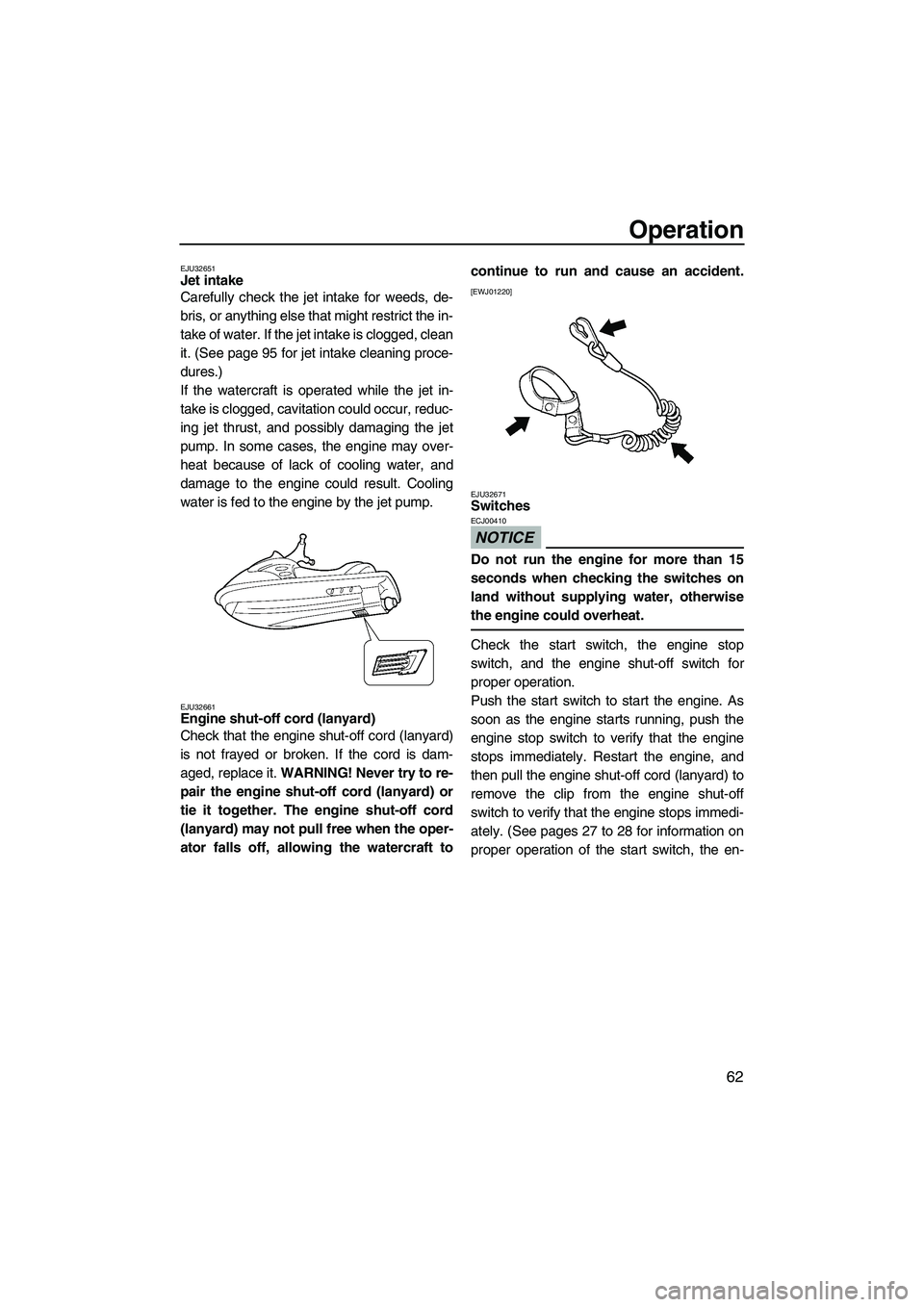
Operation
62
EJU32651Jet intake
Carefully check the jet intake for weeds, de-
bris, or anything else that might restrict the in-
take of water. If the jet intake is clogged, clean
it. (See page 95 for jet intake cleaning proce-
dures.)
If the watercraft is operated while the jet in-
take is clogged, cavitation could occur, reduc-
ing jet thrust, and possibly damaging the jet
pump. In some cases, the engine may over-
heat because of lack of cooling water, and
damage to the engine could result. Cooling
water is fed to the engine by the jet pump.
EJU32661Engine shut-off cord (lanyard)
Check that the engine shut-off cord (lanyard)
is not frayed or broken. If the cord is dam-
aged, replace it. WARNING! Never try to re-
pair the engine shut-off cord (lanyard) or
tie it together. The engine shut-off cord
(lanyard) may not pull free when the oper-
ator falls off, allowing the watercraft tocontinue to run and cause an accident.
[EWJ01220]
EJU32671
Switches
NOTICE
ECJ00410
Do not run the engine for more than 15
seconds when checking the switches on
land without supplying water, otherwise
the engine could overheat.
Check the start switch, the engine stop
switch, and the engine shut-off switch for
proper operation.
Push the start switch to start the engine. As
soon as the engine starts running, push the
engine stop switch to verify that the engine
stops immediately. Restart the engine, and
then pull the engine shut-off cord (lanyard) to
remove the clip from the engine shut-off
switch to verify that the engine stops immedi-
ately. (See pages 27 to 28 for information on
proper operation of the start switch, the en-
UF1W71E0.book Page 62 Tuesday, June 24, 2008 11:46 AM
Page 70 of 108
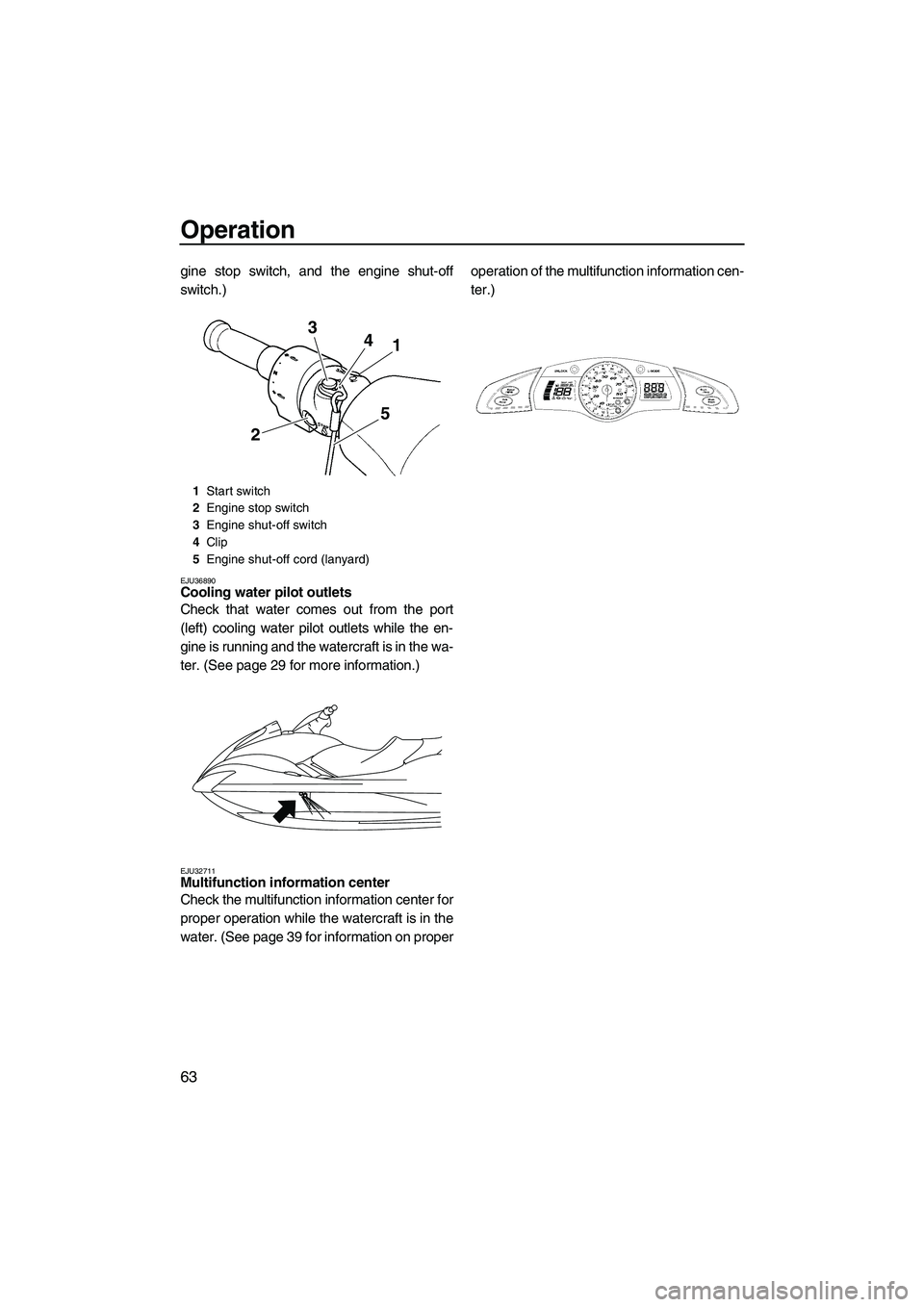
Operation
63
gine stop switch, and the engine shut-off
switch.)
EJU36890Cooling water pilot outlets
Check that water comes out from the port
(left) cooling water pilot outlets while the en-
gine is running and the watercraft is in the wa-
ter. (See page 29 for more information.)
EJU32711Multifunction information center
Check the multifunction information center for
proper operation while the watercraft is in the
water. (See page 39 for information on properoperation of the multifunction information cen-
ter.)
1Start switch
2Engine stop switch
3Engine shut-off switch
4Clip
5Engine shut-off cord (lanyard)
4
1 3
5
2
UF1W71E0.book Page 63 Tuesday, June 24, 2008 11:46 AM